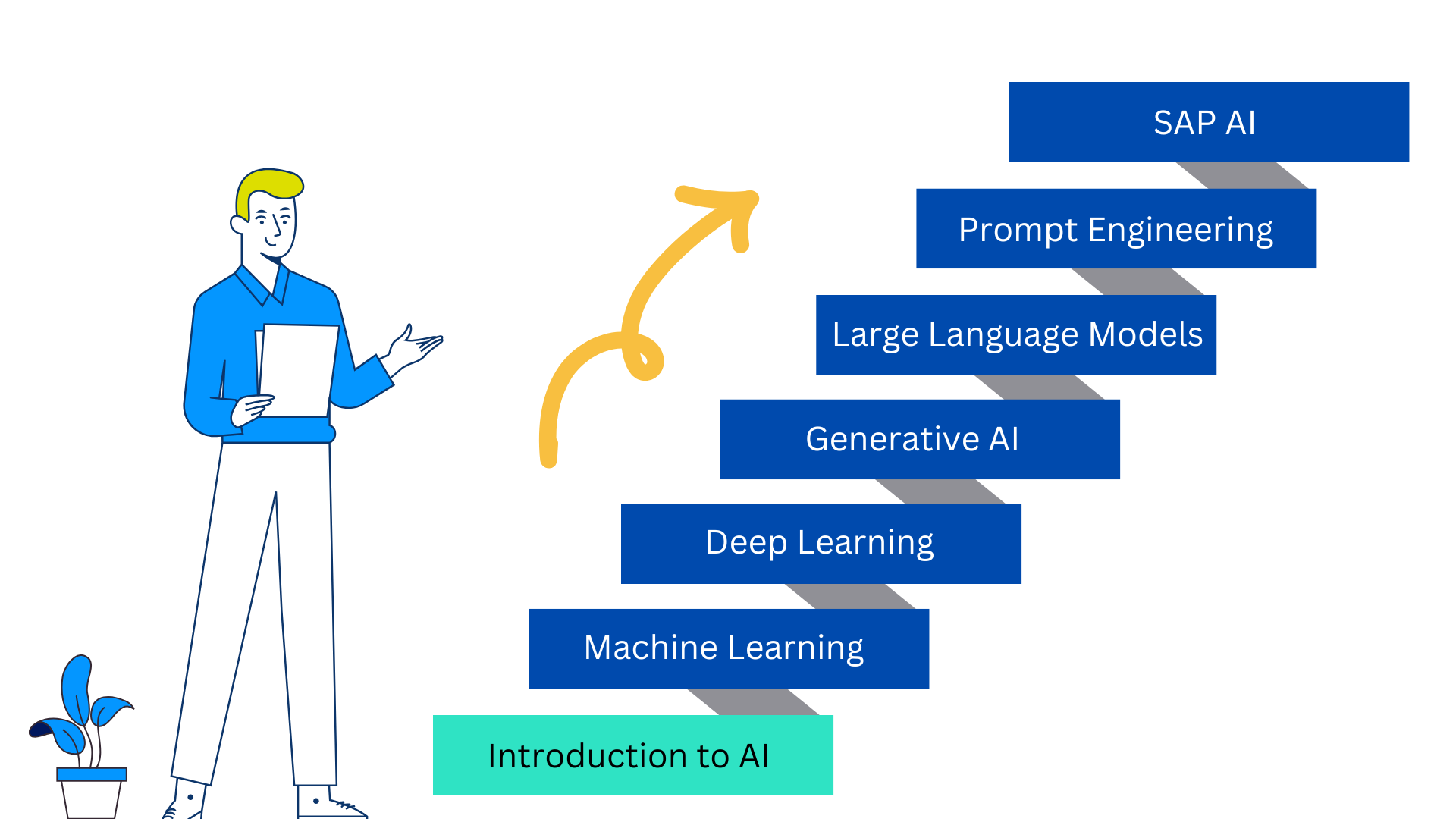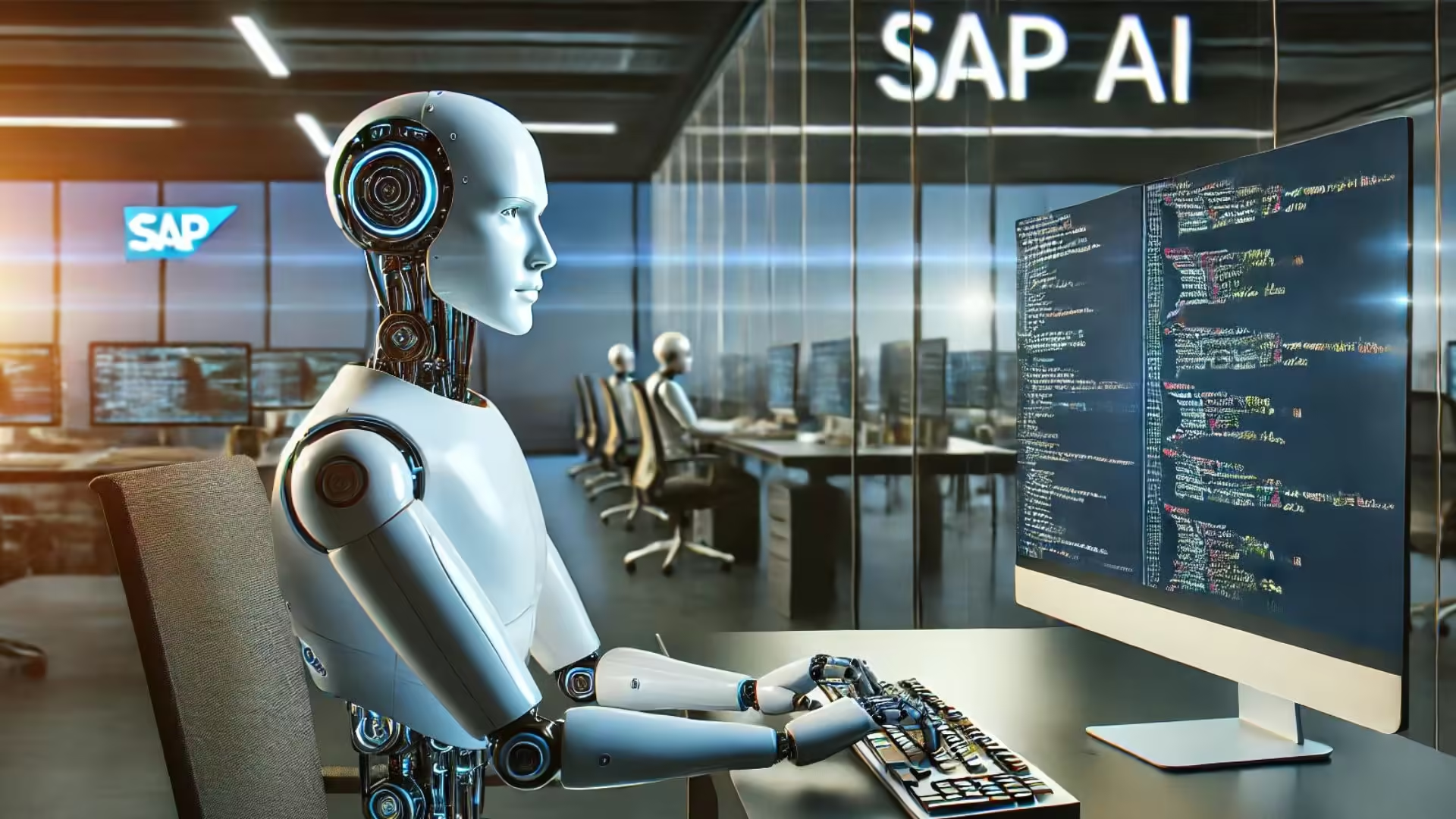Kickstart Your Journey with SAP Artificial Intelligence: Part 1 – Introduction to AI
Introduction
The term “Artificial Intelligence (AI)” was first used back in 1956, but it was mostly discussed in scientific research or shown in movies. However, with the rise of ChatGPT, AI has become a hot topic everywhere.
This 7 part blog series is designed for anyone who wants to start learning about SAP AI. No matter what your job is or what you do, understanding the basics of Generative AI how it connects to SAP is a smart choice.
In this blog series, we’ll break down SAP AI into easy-to-understand parts, covering one step at a time.

Part 1 — Introduction to AI [Current Blog]
Part 2 — What is Machine Learning?
Part 3 — Basics of Deep Learning
Part 4 — Getting Started with Generative AI
Part 5 — What Are Large Language Models (LLMs)?
Part 6 — Prompt Engineering: How to Communicate with AI
Part 7 — Introduction to SAP AI
Artificial Intelligence (AI) — A Kid’s Perspective
Let’s break down AI in a simple way. Imagine you’re looking for your favorite lost toy.
Here’s what you need to do to find it:
1. Identify Your Toy: You need to know exactly what your toy looks like.
2. Recognize Similar Items: If you find other toys, you need to tell if they’re the same as your lost toy. If it is the same type, you’ll check if it’s your specific toy.
3. Plan Your Search: You should come up with a plan to find your toy. For example:
- First, check your room.
- If it’s not there, look in the living room where you play with your toys.
- If you still don’t find it, ask your family if they’ve seen it.
4. Adapt to the Situation: If your room is messy, you might need to search carefully among the clutter.
Now, imagine someone tells you, “I saw your toy in the backyard.”
Here’s what you would do:
- You know where the backyard is and how to get there.
- You won’t mistake a different toy for your own.
- When you see the toy, you’ll check if it’s your favorite one.
You can find your toy because you have all these smart abilities.
But what if we could give these abilities to a robot so that the next time you lose your toy, the robot could help you find it?

Imagine the robot can move around and take pictures. That’s a good start, but it needs to think and act like you do. For example:
1. Identify the Room: The robot should recognize your room even if the furniture is rearranged.
2. Spot Your Toy: The robot should be able to identify your specific toy from other toys.
3. Understand Instructions: The robot needs to understand what you say and follow your directions.
4. Plan and Adapt: The robot should be able to make a search plan and adjust based on the situation, like searching more thoroughly if the room is messy.
In short, to find your toy, the robot needs to have human-like intelligence.
So Artificial Intelligence (AI) is — creating smart, human-like abilities in robots, machines, or computers.
What is AI?
Artificial Intelligence (AI) is when machines or computers are designed to imitate how humans think and make decisions.
In simple terms, AI is about making computers capable of “thinking” like humans.
AI allows computers to understand and analyze data, and make decisions on their own without needing constant human help. These smart machines use algorithms—detailed sets of instructions—to process information and get better at tasks over time.
Everyday Uses of AI
You might be using AI every day without even realizing it! Whether it’s the smart features in your apps or the technology behind your favorite services, AI is all around us, making life more convenient.
Here are some common ways AI is used in our daily lives:

Personalized Fitness Apps
Fitness apps like MyFitnessPal or Fitbit use AI to track your exercise routines and dietary habits. They analyze your data to offer customized workout plans and nutritional advice tailored to your personal goals and progress.
Navigation and Traffic Apps
When you use apps like Google Maps or Waze, AI helps find the fastest route to your destination. These apps analyze real-time traffic data to provide updates on road conditions and suggest alternative routes to avoid delays.
Smart Home Devices
Smart thermostats like Nest and security cameras like Ring use AI to learn your preferences and adjust settings automatically. For example, a smart thermostat can learn when you’re home or away and adjust the temperature to save energy while keeping you comfortable.
Email Filtering and Organization
Email services such as Gmail use AI to filter out spam and categorize your messages. AI helps organize your inbox by sorting emails into different categories, like primary, social, and promotions, so you can easily find important messages.
Streaming Music Services
Music streaming platforms like Spotify use AI to create personalized playlists based on your listening habits. AI analyzes the songs you play and suggests new music you might enjoy, enhancing your listening experience.
Voice-to-Text Apps
When you use speech-to-text features on your phone or computer, AI converts your spoken words into written text. This technology is useful for composing messages, taking notes, or creating documents hands-free.
Online Travel Booking
Travel websites like Expedia or Booking.com use AI to recommend flights and accommodations based on your past searches and preferences. AI helps you find deals and options that match your travel needs and budget.
These examples illustrate how AI is integrated into our daily routines, making tasks easier and more efficient while often working quietly behind the scenes.
Understanding AI Types
Let’s break down the types of AI in a way that’s easy to understand. Imagine AI as different kinds of robots or programs that can do different things. Here are the main types:
1. Narrow AI
Think of Narrow AI as a robot that is really good at doing just one specific job. For example, imagine a robot that can only play chess. It’s amazing at chess but can’t do anything else, like make sandwiches or tell jokes. Most of the AI we use today is Narrow AI. For instance, Siri on your phone can help with setting reminders or telling you the weather, but it can’t do your math homework or walk your dog.
Example: A calculator is a type of Narrow AI. It’s great at doing math, but it can’t help you with writing a story or making a drawing.
2. General AI
General AI is like having a super-smart robot that can do almost anything a human can do. It can play chess, help with homework, cook dinner, and even understand jokes. Right now, we don’t have General AI. It’s more like something you might see in movies where robots are almost as smart and versatile as humans.
Example: Imagine a robot that can help you with school projects, play games, and even chat with you about your favorite TV shows. This robot would be able to learn and do many different things, just like a person.
3. Artificial Superintelligence (ASI)
This is the most advanced type of AI, which is smarter than any human in every possible way. ASI would be able to solve complex problems, invent new things, and make decisions better than anyone else. But, this kind of AI only exists in science fiction for now.
Example: Think of a robot that could solve any puzzle in the world, create incredible art, and invent new technologies that we haven’t even thought of yet. It’s like having a super-genius robot who knows everything!
Generative AI fits under Narrow AI
Generative AI is a special kind of Narrow AI that can create new things. Instead of just following rules or doing tasks, it can make new content, like writing stories, drawing pictures, or composing music. For example, a Generative AI might help you write a fun story about a dragon and a spaceship, or it could generate a new piece of music based on your favorite songs.
Example: Think of an AI that helps you design a new video game level or comes up with new ideas for a storybook. It uses what it knows to create something new and original.
Generative AI fits under Narrow AI because it specializes in creating new content and isn’t yet capable of the broad range of abilities that General AI would have.
AI vs. Human Intelligence: Key Differences
Artificial Intelligence (AI) and human intelligence each have their unique strengths and characteristics. While AI is remarkable at handling numbers and rules with remarkable speed and accuracy, human intelligence brings emotional depth, creativity, and adaptability. Think of AI as a super-efficient calculator, whereas human intelligence is like a vibrant, ever-evolving work of art!

Here’s a closer look at how AI and human intelligence differ:
How They Learn:
- AI: Learns by analyzing vast amounts of data and identifying patterns. It becomes proficient in specific tasks by processing numerous examples.
- Humans: Learn through direct experiences, conversations, and exploration. Our learning encompasses everything from mastering new skills to understanding the beauty of natural phenomena.
Speed of Thinking:
- AI: Executes tasks at lightning speed, especially those it has been trained on. It’s highly efficient with repetitive and well-defined activities.
- Humans: May take a bit more time, but we excel at tackling complex problems and applying creative thinking to find innovative solutions.
Memory Capabilities:
- AI: Retains information and facts based on programming but lacks personal experiences or emotions. It recalls data without the context of personal significance.
- Humans: Remember events, emotions, and personal details, like cherished memories or favorite songs. Our memories are a blend of both joyful and challenging experiences.
Emotional Understanding:
- AI: Does not experience emotions. It operates based on predefined rules and patterns.
- Humans: Experience a wide range of emotions, such as joy, sadness, and empathy. Our feelings significantly influence our actions and interactions with others.
Adaptability:
- AI: Functions based on its training and may struggle with unfamiliar situations. It is highly efficient but limited to its programmed scope.
- Humans: Are highly adaptable and resourceful. We thrive in new and unpredictable scenarios, using creativity and critical thinking to navigate challenges.
Creativity and Innovation:
- AI: Creates within its defined parameters. It’s like an artist working with a specific set of tools and constraints.
- Humans: Are adept at generating novel ideas and solutions. Our creativity allows us to invent new concepts and push beyond existing boundaries.
Understanding Context:
- AI: Knows what it has been taught but might struggle with nuanced contexts, such as interpreting humor or cultural subtleties.
- Humans: Have a deep understanding of complex social interactions, humor, and cultural nuances. Our brains integrate diverse types of information to make sense of the world.
Decision-Making:
- AI: Makes decisions based on data and programming. It follows logical rules and algorithms.
- Humans: Use a combination of logic, emotions, and personal values to make decisions. Our choices reflect our unique perspectives and experiences.
In summary, AI and human intelligence each excel in their own ways. AI is a powerhouse of speed and precision for specific tasks, while human intelligence is enriched with creativity, emotional depth, and adaptability.
Summary
In this blog, we’ve explored the fundamental concepts of Artificial Intelligence (AI), starting from its basic definition to its real-world applications. We’ve simplified AI by comparing it to a robot that helps you find a lost toy, illustrating how AI mimics human-like problem-solving abilities. We discussed various everyday uses of AI, such as in fitness apps, navigation tools, and smart home devices, demonstrating its pervasive impact on our daily lives.
We also categorized different types of AI, including Narrow AI, which excels at specific tasks, General AI, which remains a theoretical concept with broader capabilities, and Artificial Superintelligence (ASI), a futuristic idea of AI surpassing human intelligence. Lastly, we introduced Generative AI, a type of Narrow AI that creates new content, showcasing its innovative potential.
This foundational understanding sets the stage for our upcoming discussions, where we’ll delve deeper into machine learning, deep learning, and the specifics of Generative AI. Stay tuned as we continue to break down these exciting topics in the next parts of our series.



